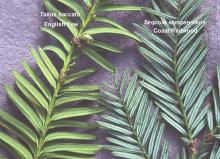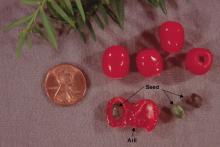Taxus baccata
Common name:
English Yew
Pronunciation:
TAKS-us ba-KA-ta
Family:
Taxaceae
Genus:
Type:
Conifer
Native to (or naturalized in) Oregon:
No
- Conifer, evergreen tree/shrub, wide spreading, 30-60 ft (9-18 m) high with a 15-25 ft (5-8 m) spread, densely branched, many forms. Needles radially arranged around the stem but appearing more or less 2 ranked, 1-3 cm long, 1.5-6 mm wide, linear, tapering to a horny point, shining, very dark green on the upper surface, yellowish green below (lack a conspicuous stomatal band). Usually dioecious, yellowish male strobili, arise on the axils of leaves on the underside of branches. Fruits have a fleshy, scarlet, cup-shaped covering (aril) which is 8-15 mm long and open at the apex, it encloses a single seed. Seeds are poisonous.
- Sun or shade. Tolerates many soil conditions, except strongly alkaline or acid soils.
-
Hardy to USDA Zone (5)6 Native to Europe, northern Africa, and western Asia; cultivated in England for over 1,000 years and many selections made. If fact, shrubby cultivars are much more often used in landscaping than the species. Here are a few cultivars:
- 'Amersfoort' - dwarf shrub, upright irregular habit, slow growing, feaves flat, small, light to dark green
- 'Fastigiata' - (Irish Yew) narrowly columnar or spindle-form, branches are rigidly upright; needles are dark green
- 'Repandens' - dwarf, wide spreading form, 2-4 ft high (0.6-1.2 m), branches horizontal, tips of branches pendulous
- 'Repandens Aurea' - variegated, low growing shrub, green leaves brightly edged with yellow-turning-to-cream
- 'Standishii' - tree/shrub, columnar, compact, upright shoots, leaves golden-yellow above, light yellow-green below
- Leaves, bark, and broken seeds are poisonous, although the toxicity varies from plant to plant. Symptoms may include cardiac or respiratory failure. The poisonous substances in yew are pseudo-alkaloids known as taxines. They are a mixture of polyhydroxyditerpines (taxinins) esterified with ß-dimethylamino-ß-phenylpropionic acid and/or acetic acid (Frohne, D. and H.J. Pfänder, 1984).
- baccata: Latin, berry-bearing
- Oregon State Univ. campus: lower campus, on 11th St. across from Dixon Lodge







